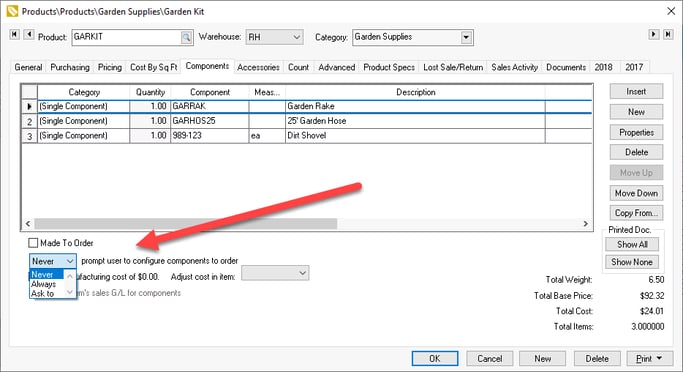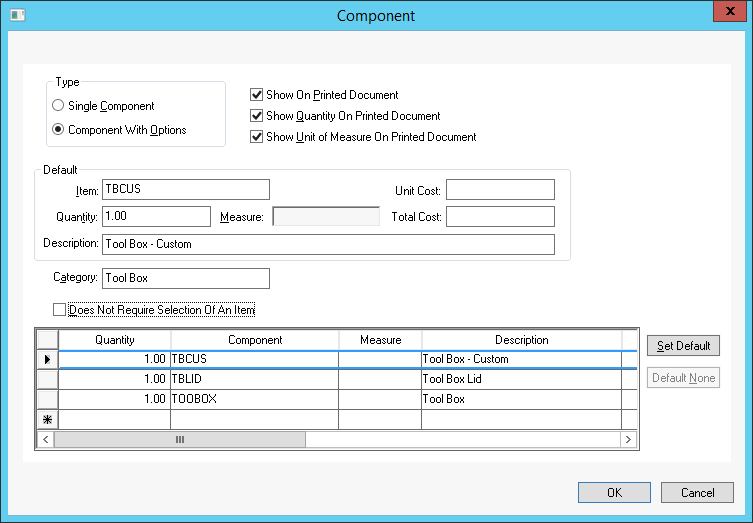Configure to Order (CTO) Process Overview
The Configure to Order (CTO) process is used to sell custom kits that are purchased from a vendor as a kit. For example, a user may purchase a custom machine with various options or components from a vendor. The custom machine may come in many variations and the seller using EBMS may not want to create an inventory ID code for each possible variation. A few possible vertical markets that may use this feature:
-
Custom equipment with various options or variations.
-
Custom-made hoses or assemblies that may contain various fittings or couplings.
-
Custom-built storage sheds with various colors, sizes, and options.
-
Custom-made furniture with various modifications, stains, colors, or other options.
Do not use the Configure to Order (CTO) process in the following situations:
-
Items that are customized or modified internally. Review the Made to Order (MTO) Kitting Overview section for instructions on how to build or assemble items with options that are assembled by the EBMS user.
-
Parts that are purchased as components and sold as a customized assembly. Review the Components and Accessories Overview section for instructions on kitting and components.
-
Variations of an item being sold that are purchased from a vendor using different vendor part numbers. Review the Product Attributes Overview section for instructions on compiling a catalog with a large volume of part numbers to identify the various options available.
The benefits of this process is that the user can create an inventory item with the following variations:
-
Costs can vary based on the user-selected component options. Review the Optional Components or Accessories section for more details.
-
Pricing can be calculated based on which components the user selects. Review the Optional Components or Accessories section for more details.
-
Optional components can be used to create a custom description for an inventory item. Review the following Selling a Configure to Order Item section.
-
The special order process within EBMS can create a purchase order, including the custom item description, directly from the sales order. Review the Purchasing a Configure to Order Item section for more details.
-
EBMS's powerful special order tools can assist with the ordering, receiving, and managing of the custom item from the time the customer places the order until the sale is completed.
Enable the Configure to Order Option
The following global options must be enabled to use the new powerful Configure to Order (CTO) option:
-
Create a new inventory product within EBMS by selecting Inventory > New Product. Review the Entering New Products section for more information on creating new inventory items.
-
Open the General tab of the inventory item and choose your desired Classification such as Track Count, No Count, or any other classification with exception of Service. Review the Inventory Classifications for a complete list of classification options.
-
Select the product record Pricing tab and set up the pricing for the custom Configure to Order (CTO) item. The pricing can either be set up as a fixed price (no matter which components are selected), or the pricing can be set up so that the optional components change the pricing according to the options selected. Review the Option and Kit Pricing section for more details on variable prices based on the options selected. Review the Price Formula section for more details on fixed pricing.
-
Select the Count tab to set the correct Purchase Method.
Associated is the recommended Purchase Method setting for a Configure to Order (CTO) item. Do not use the Stocked (Standard) or Replenishment purchase methods for a CTO item. Review the Purchase Methods section for more details on the purchase method options.
-
Select the Components tab as shown below:

-
Configure the prompt user to configure components to order option by selecting Never, Always, or Ask To. This option is located below the component list as shown above.
-
Complete the following steps to add optional components to the CTO item:
- Select New from the right side of the Components tab to add a customizable option. The following Component dialog will appear.

- Select the Component with Options type, as shown above.
- Enable the following Show... options to copy the optional component description to the sales order and purchase order.
- Enable the Show on Printed Document option to show the optional component description within a sales order, proposal, or purchase order.
- Enable the Show Quantity on Printed Document option to display the quantity of items within each custom Configure to Order item. (If the quantity of items on the component list equals one, the quantity will not show even if this option is enabled. This option will be prompted by a quantity of two or more.)
- Enable the Show Unit of Measure on Printed Document option to display the component's unit of measure setting.
- Add a Category description. This description is used to categorize the optional components and will not show within the Configure to Order description.
- Create the optional Component table by adding a list of inventory items. These inventory IDs must be inventory items classified as No Count. Note that these items are not required to be actual inventory but may be items created only to identify the descriptions, pricing, and costs of the Configure to Order item. Review the Optional Components or Accessories section for more details on configuring optional components.
- Highlight the most commonly used inventory option and select Set Default.
- Click OK to save the component with the option list.
- Select New from the right side of the Components tab to add a customizable option. The following Component dialog will appear.
- Repeat these steps for each component or option within the customized Configure to Order (CTO) item.
All kitting options must be disabled for Configure to Order items
- The following Assembly Kit option must be disabled in the Components tab of an inventory item classified as No Count. Review the Entering Components into the Materials List section of the sales documentation for details on enabling the Assembly Kit option for kits and assemblies.

- The following Made to Order kitting option must be disabled in the Components tab of an inventory item classified as Track Count or any other perpetual inventory item. (Note that this option may be for Assembly Kit or Made To Order, based on the product's settings.) Review the Made to Order (MTO) Kitting Overview section for more details on enabling the Made to Order kitting option.

Review the Changing Product Information section for details on the inventory item settings.
Review the following section, Selling a Configure to Order Item for details on processing the sale of a CTO item.
Review the Purchasing a Configure to Order Item section for details on creating a purchase order from the Configure-To-Order sales order.
Training Video: Configure to Order ERP Support Training